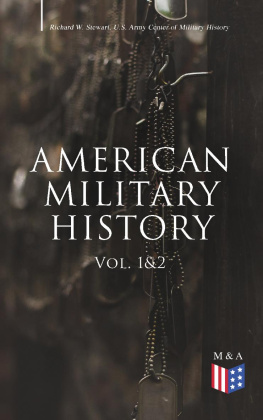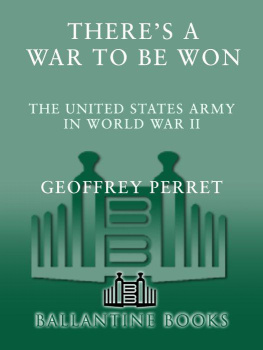Richard W. Stewart & U.S. Army Center of Military History
American Military History (Vol. 1&2)
The United States Army From the American Revolution to the Global War on Terrorism
Madison & Adams Press, 2018. No claim to original U.S. Government Works
Contact:
ISBN = 978-80-268-8872-7
This is a publication of Madison & Adams Press. Our production consists of thoroughly prepared educational & informative editions: Advice & How-To Books, Encyclopedias, Law Anthologies, Declassified Documents, Legal & Criminal Files, Historical Books, Scientific & Medical Publications, Technical Handbooks and Manuals. All our publications are meticulously edited and formatted to the highest digital standard. The main goal of Madison & Adams Press is to make all informative books and records accessible to everyone in a high quality digital and print form.
Preface
The story of the United States Army is always growing and changing. Historians constantly seek to reinterpret the past while accumulating new facts as Americas Army continues to be challenged on new foreign battlefields. Nor does the Army, as an institution, ever stand still. It necessarily changes its organization, materiel, doctrine, and composition to cope with an ever-changing world of current conflict and potential danger. Thus, the Center of Military History is committed to preparing new editions of American Military History as we seek to correct past mistakes, reinterpret new facts, and bring the Armys story up to date. This new edition of that textbook, an important element in soldier and officer education since 1956, seeks to do just that.
This edition of American Military History builds on the previous edition, published in 2005, and expands its coverage to include an analysis of the wars in Afghanistan and Iraq up to January 2009. This expanded section is necessarily only an initial survey of the first eight years of the war on terrorism; it is far from the final word on the subject. It may take an additional decade or more to collect sufficient documents, interviews, memoirs, and other sources to know the details of military and political planning, the implementation of those plans on the global battlefield, and the impact on the Army as an institution and on the nation. The events of the past eight years are more like current events than they are history. Historythe detailed telling of a story over time based upon all the extant evidencerequires more time to find and analyze the documents and facts and bring to bear on that evidence the insight that comes only from perspective. However, todays soldiers need their story told. The events in which they participate and in which they are such important elements need to be given some form and order, no matter how tentative. The Army continues to be the nations servant, and the soldiers that make up that Army deserve their recognition. They continue to protect our freedom at great personal risk to themselves and incalculable cost to their loved ones. This is their continuing story.
RICHARD W. STEWART
Chief Historian
Washington, D.C.
24 September 2009
Over the years numerous military historians have contributed to the earlier versions of this textbook published in 1956, 1969, and 1989. In this latest telling of the story of the U.S. Army, additional scholars inside and outside the Center of Military History have conducted research, written or revised chapters and inserts, or reviewed the texts of others. Other experts have edited text, proofed bibliographies, prepared maps, and located photographs to bring this book together.
It is important to highlight those historians and other professionals who have helped make this book a reality. Indeed, there were so many contributors that I hasten to beg forgiveness in advance if I have inadvertently left someone off this list. First, I wish to thank those many scholars outside the Center of Military History who voluntarily gave of their time to review chapters of this book and provide their expertise to ensure that the latest scholarship and sources were included. These scholars include: John Shy, Don Higginbotham, Robert Wright, John Mahon, William Skelton, Joseph Dawson, Joseph Glathaar, Gary Gallagher, Carol Reardon, Mark Grimsley, Perry Jamieson, Robert Wooster, Brian Linn, Timothy Nenninger, Edward Coffman, David Johnson, Stanley Falk, Mark Stoler, Gerhard Weinberg, Edward Drea, Steve Reardon, Allan R. Millett, Charles Kirkpatrick, and Eric Bergerud. Their careful reviews and suggested additions to the manuscript enriched the story immeasurably and saved me from numerous errors in interpretation and fact. Within the Center of Military History, of course, we have a number of outstanding historians of our own to draw upon. The Center is, I believe, as rich in talent in military history as anywhere else in the country; and I was able to take advantage of that fact. In particular, I would like to thank the following historians from the Histories Division for their writing and reviewing skills: Andrew J. Birtle, Jeffrey A. Charlston, David W. Hogan, Edgar F. Raines, Stephen A. Carney, William M. Donnelly, William M. Hammond, and Joel D. Meyerson. Within the division, every member participated in writing the short inserts that appear throughout the text. In addition to the names previously listed, I would be remiss if I did not also thank Stephen J. Lofgren, William J. Webb, Dale Andrade, Gary A. Trogdon, James L. Yarrison, William A. Dobak, Mark D. Sherry, Bianka J. Adams, W. Blair Haworth, Terrence J. Gough, William A. Stivers, Erik B. Villard, Charles E. White, Shane Story, and Mark J. Reardon. Whether they have been in the division for one year or twenty, their contributions to this work and to the history of the U.S. Army are deeply appreciated.
I particularly wish to thank the Chief of Military History, Brig. Gen. John Sloan Brown, for his patience and encouragement as he reviewed all of the text to provide his own insightful comments. He also found time, despite his busy schedule, to write the final two chapters of the second volume to bring the story of the U.S. Army nearly up to the present day. Also, I wish to thank Michael Bigelow, the Centers Executive Officer, for his contribution. In addition, I would like to note the support and guidance that I received from the Chief Historian of the Army, Jeffrey J. Clarke, and the Editor in Chief, John W. Elsberg. Their experience and wisdom is always valued. I wish to thank the outstanding editor of American Military History, Diane M. Donovan, who corrected my ramblings, tightened my prose, and brought consistency to the grammar and style. Her patience and skilled work made this a much finer book. I also wish to thank those who worked on the graphics, photographs, and maps that helped make this book so interesting and attractive. This book would not have been possible without the diligence and hard work of the Army Museum System Staff, as well as Beth MacKenzie, Keith Tidman, Sherry Dowdy, Teresa Jameson, Julia Simon, and Dennis McGrath. Their eye for detail and persistence in tracking down just the right piece of artwork or artifact or providing the highest quality map was of tremendous value.







